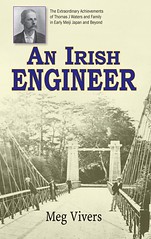
PREV ARTICLE
NEXT ARTICLE
FULL ISSUE
PREV FULL ISSUE
NEW BOOK: AN IRISH ENGINEERMeg Vivers of Australia writes: I have now received some advance copies of my book An Irish Engineer, which is about Tom Waters who designed the Osaka Mint in c. 1869.
Below is the press release Meg provided. Thanks, and congratulations on what looks like an interesting book.
-Editor
in Early Meiji Japan and Beyond Meg Vivers Hardcover, RRP in Australia $36.50, ISBN 978-1921452048, CopyRight Publishing, Brisbane, Australia (Softcover version also available.)
An Irish Engineer takes the form of a biography, with voices from the past adding a sense of place, immediacy and authenticity to the information taken from more public (and sometimes less reliable) documents, such as newspapers and government records. Through the fortunate discovery of a large collection of Waters family letters, diaries and journals the author has, in many cases, been able to trace the movements of Tom Waters and his family from a personal perspective exploring, in-depth, their lives, their achievements, and the choices that they made, in a world on the cusp of extraordinary change. Within this biographical framework, some of the buildings and other structures created by Tom Waters are described in detail – the most important of these being the Mint at Osaka and Western-style buildings for the Ginza region in Tokyo. There is discussion, too, on the engineering and entrepreneurial activities of the Waters brothers and their relatives elsewhere in the world. This fascinating narrative crosses international boundaries and engages with generations of men. It is a story of enterprise and opportunism, of networks and family connections. But, most of all, it is a story of beginnings. Because, for such men, being first was the secret to their success. Thomas Waters’ story is intimately involved with the beginning of the Westernised East. As such, it would be of interest to many historians, especially those concerned with the effect of the industrial revolution in Great Britain and the influence of the West on Japan during the early years of Meiji. Furthermore, because the book has a biographical format, and contains extracts from letters and journals, it should appeal to a wider readership. This is the second book by Meg Vivers on the subject of the Waters family. The first, Castle to Colony: the Remarkable Life and Times of Lucy Sarah Gray (1840–1879), also published by CopyRight, traces the life of Lucy Gray (née Waters), a sister of Thomas, Ernest and Bertie Waters. During her short adult life Lucy lived in some of the most remote parts of colonial New Zealand and Australia, and left behind descriptive journals and correspondence, supported by sophisticated drawings and paintings. In the words of eminent colonial historian, Professor Alan Atkinson: ‘Of all the depictions of colonial Australia which survive from a woman’s point of view, Lucy Gray’s is among the richest and best’. Comprehensive research into this remarkable family, and the contribution they made to Britain’s influence throughout the world, has long been overdue. Both books provide a better understanding of a period of great economic, industrial, religious and cultural upheaval, as complex liaisons evolved, not only between East and West, but also between Great Britain and its colonies. In his review of An Irish Engineer, Professor David Kent of the University of New England, Armidale wrote: The grandest and most sweeping histories are distilled from the collected experience of individuals… This well written, impressively researched and fascinating book adds to our understanding of the way the engineering profession evolved in mid-Victorian Britain, of how family networks and connections often provided the platform on which careers might be built … Copies of An Irish Engineer can be purchased by contacting Meg Vivers in Australia at mvivers@une.edu.au, or through the Telluride Museum in Colorado USA at http://www.telluridemuseum.org/shop/. If posted from Australia, packaging and postage costs would be added to a discount price. Meg adds: If any of your members are interested in purchasing a copy they could do so in one of the following ways: 1. For those in Canada or USA it might be convenient to order through the Museum at Telluride, Colorado, at www.telluridemuseum.org/shop/ 2. For those living elsewhere it would perhaps be best to order from me direct at mvivers@une.edu.au. I can provide the book at a discount, but the total charge would depend upon the postage. I use Pay Pal, which seems to be the easiest method for international transactions. I do not know how much the Museum will charge. I will have both hard cover and soft cover (paper back) versions of the book for sale. However, the soft cover version would seem to be more suitable for posting long distance, at least when multiple copies are involved. The Telluride Museum will only have the paperback version. Wayne Homren, Editor The Numismatic Bibliomania Society is a non-profit organization promoting numismatic literature. See our web site at coinbooks.org. To submit items for publication in The E-Sylum, write to the Editor at this address: whomren@gmail.com To subscribe go to: https://my.binhost.com/lists/listinfo/esylum All Rights Reserved. NBS Home Page Contact the NBS webmaster 
|
